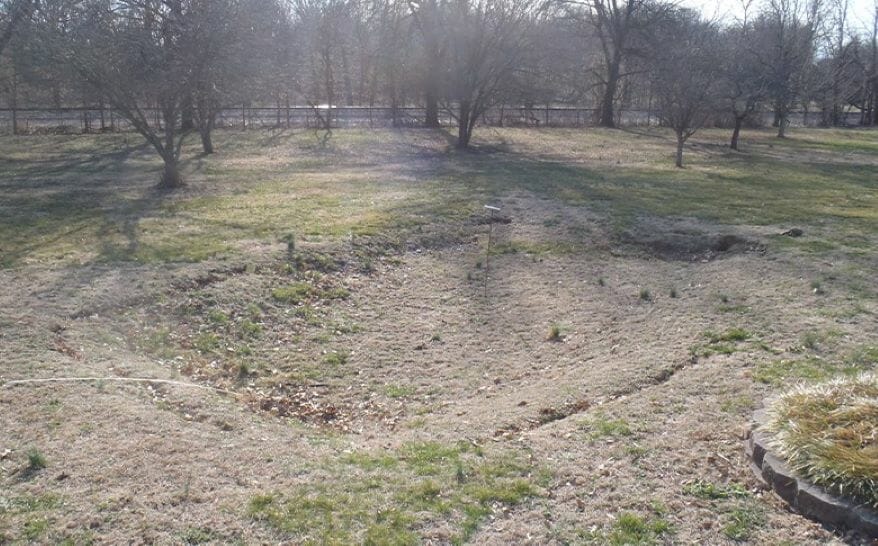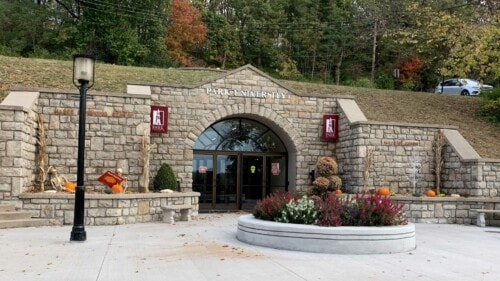That Sinking Feeling: Missouri Full of Caves, Sinkholes Show-Me State has the Second Most Caves in the Country
Published June 27th, 2023 at 6:00 AM
Above image credit: A sinkhole in Barry County, Missouri. (Courtesy | Missouri Department of Natural Resources)In the heart of Missouri lies a sinkhole.
It consumes around 700 acres of land in Boone County — stretching about a mile wide and reaching about 100 feet in depth. It’s the state’s largest sinkhole, but it’s just one of thousands that puncture holes throughout the Show-Me State.
About 200 miles away, Missouri’s longest cave swirls for miles in Perry County. The cave, called Crevice Cave, is currently surveyed to stretch 31.2 miles, according to the Missouri Speleological Survey.
Missouri boasts a landscape freckled with geologic features like caves and sinkholes. This is because Missouri’s bedrock — composed of soluble rock like limestone and dolomite — is conducive to karst formation. Karst is a term used to describe landscapes where bedrock dissolves to create geologic features like caves and sinkholes.
“We have an awful lot of limestone and dolomite in Missouri — an awful lot of it,” said Robyn Daniels, a geologist at the Missouri Geological Survey. “If you look at (a) geologic map of Missouri, you’re gonna see a very large portion of the surface, you know, the closest to the surface rock being limestone or dolomite.”
In the southeast corner of Missouri sits a large, circular structure called the Ozark Dome, said Jeff Crews, a geologist at the Missouri Geologic Survey. At the flanks of the dome sit large quantities of limestone and dolomite, which are soluble in weak acids, Crews said.
“And so basically if you have rainwater picking up carbon dioxide out of the atmosphere and out of the soil zone, slowly seeping into the ground, it reacts with these rocks and literally like dissolves them away,” Crews said. “It can dissolve out little holes and those holes can grow to connect it to little conduits and those conduits can grow to become caves or springs.”
City Beneath Us: Exploring Missouri’s Thousands of Caves
The dissolution of limestone and dolomite has resulted in the thousands of caves that crawl beneath the surface of Missouri, carving out branching veins that wind and whirl and weave through the sedimentary rock.
Current estimates put Missouri at about 7,700 documented caves, the second most documented in the country behind Tennessee, according to Dan Lamping, president of the Missouri Speleological Survey. But that number is fluid, and Missouri adds about 100 new caves per year, Lamping said.
“Sometimes we lose some (caves), though, as we find that we’ve got information in our database that perhaps we have reference to a cave, but we don’t have any known location to it,” Lamping said. “Or we know the location that we have is bad.”
Missouri’s caves are primarily concentrated in the southern and eastern portions of the state.
“Well, if you’re gonna be a caver, you want to be in eastern Missouri,” said Jim Cooley, treasurer of the Kansas City Area Grotto and fellow at the Cave Research Foundation. “Kansas City is on the Great Plains, and we are on something called Mississippian and Pennsylvanian limestone, which is not particularly speleogenic. In other words, not a lot of caves here.”
Caves, despite a lack of sunlight and other sources of energy, are not entirely devoid of life. Some species have completely adapted to living in the low-energy cave environments, Cooley said.
“There’s a couple of cave fish in Missouri that are blind and pure white — they don’t need pigments underground and they live in the aquifer, or you know, underground streams and many of them will never be at a place where there’s a surface to the water,” Cooley said. “They’ll spend their whole life in tubes full of water deep within the earth that have leaf litter washed into them through the sinkholes on the surface, but they’re very few and far between. So they’re hard to study and hard to find — they are there though.”
Studying caves can aid scientists in learning more about evolutionary processes and changes within species, as well as provide insight into the prehistoric world and groundwater quality, Lamping said.
“So caves are vulnerable environments,” Lamping said. “They’re sensitive to disturbance from activities on the surface and activities from people — they are homes to diverse fauna, cave-adapted species that are in some cases only found in singular caves. For all that we know about caves and cave biology, there is much more that we don’t know.”
A number of laws and regulations exist to protect caves and the species and resources that exist within them. Caves in Missouri State Parks are closed during the winter months to protect bats from white-nose syndrome.
“White-nose syndrome is a fungal infection that affects bats, and in particular … it affects them most during winter when they’re hibernating,” Lamping said. “And not all bats use caves, and fewer bats use caves in the summer, but many bats do use caves in the wintertime to hibernate and white-nose syndrome will cause bats to awaken more frequently during hibernation, which forces them to use some of their fat reserves.”
The infection has caused a significant decline in several bat species, Lamping said. To mitigate any further spread, cavers typically decontaminate their gear between trips to kill any spores that might have attached to their clothing, Lamping said.
Individuals in the Kansas City area who are interested in learning more about caves should connect with the Kansas City Area Grotto, Cooley said. Cooley also said it is important to learn how to explore caves safely from people who do it on a full-time basis.
“There are things that can go wrong in caves that you need to be aware of and know how to cave safely before you go off exploring caves,” Cooley said.
Sinkholes, and Their Hazards, Proliferate in Missouri
The conditions that produce caves are also favorable for sinkholes. The Missouri Department of Natural Resources has documented about 16,000 sinkholes throughout the state.
Sinkholes form due to the dissolution of bedrock or when caves collapse, according to the Missouri Department of Natural Resources.
The largest known sinkhole in Missouri is large enough that it feels like driving through a valley, Fletcher Bone, a geologist at the Missouri Geological Survey, said.
“It’s very misleading,” Bone said. “If you pull up a topographic map and look at it you’ll (say), ‘Oh okay, this makes sense now.’ But driving through there, it’s large enough that you wouldn’t even know you’re going into a sinkhole.”
Some hazards can be associated with sinkholes, Bone said.
“Of course, building a house or any kind of structure on or near a sinkhole or even in an area that has a high probability of sinkholes — that can be an issue,” Bone said.
Sinkholes can also be associated with flash floods, Bone said. Additional problems include instances where sinkholes collapse under roadways or gas or utility lines, according to Bone.
Over the last 15 years, damages resulting from sinkhole collapses nationally rack up an estimated average of at least $300 million each year, according to the United States Geological Survey.
“In my experience, we get a lot of phone calls from people (in) about March, April — kind of after you’ve had typically a longer dry winter (and) we’ve gone through lots of freeze-thaw cycles…” Bone said.
Data from the Kansas City, Missouri, Open Data Portal records reports made about sinkholes to 311 throughout the city.
Over the last five years, these sinkhole reports to 311 tended to increase during the spring months. Bone said this is likely due to thawing and more rain water.
“A lot of people don’t get out much during the wintertime, so when it gets nice out, people start walking around their yards more and then, you know, something might have been there a couple months too,” Bone said. “But definitely having the freeze-thaw cycles and the spring rains will definitely exacerbate those conditions.”
However, Bone said the Kansas City, Missouri, reports are not typically the result of naturally occurring sinkholes, but infrastructure issues. These kinds of instances are referred to as a collapse or a subsidence, rather than a sinkhole, Bone said.
“The Kansas City area the bedrock type is not typically conducive for sinkhole formation,” Bone said.
Though there is limestone in Kansas City, the clays and shales in the area slow down the percolation rate of groundwater, according to Bone.

Bone said studying sinkholes, and karst in general, contributes to the protection of groundwater.
“So say you had a tanker truck tip over on Highway 63, and it happened to be right next to a sinkhole and 5,000 gallons of diesel fuel dumped into the sinkhole,” Bone said. “We got to figure out where that’s gonna go.”
Window Into the Past: What Missouri’s Rocks Reveal
Missouri’s geology is varied, Daniels said.
“Missouri is the best,” Daniels said. “Missouri has a wide range of different types of rocks. Whatever you’re interested in — whether it’s looking at igneous rocks or sedimentary rocks. We also have the New Madrid seismic zone, so if you’re interested in that.”
Missouri has a few official geologic symbols. Missouri’s official state rock is Mozarkite — a form of chert found only in Missouri. It also has an official state dinosaur. Parrosaurus missouriensis was a plant-eating hadrosaur whose bones were found in the 1940s in Bollinger County, Missouri.
In addition to the variety of geological features Missouri offers, Daniels said the time element of studying geology is also compelling.
“You live the life you’re living, right? And you don’t think about the world being a dynamic place and the environment changing so drastically, but it really has changed very drastically over time,” Daniels said. “And it’s not just because of environmental conditions changing, it’s because we have tectonics going on and so the land masses are moving around to different places on the globe. You can think of Missouri 350 million years ago — which is approximately the age of the rocks in Kansas City … and you’re in a completely different environment — it’s a coastal environment. I think that’s really important.”
Crews said studying rocks allows geologists to look into the past, providing them the opportunity to piece together age dating and understand what the environment was like in the past. Caves are basically housing those little nuggets of information, Crews said.
“I was reading an article about Beetlejuice the star, right? They think it’s going to go supernova here relatively soon,” Crews said. “The age of that star formation, when it started … 10 million years ago. And that sounds like a really long time, right? But that means that the dinosaurs never saw that star … that star is a baby. The rocks outside your house, pretty much wherever you are in Missouri, are older than that star.”
Julie Freijat is a Dow Jones reporting intern at Kansas City PBS. She is a masters student at the University of Missouri.




Great article, caves are the one thing I love about this state! Highly recommend a spelunking trip.
*Side note, the star is Betelgeuse, and a pretty cool story of its own